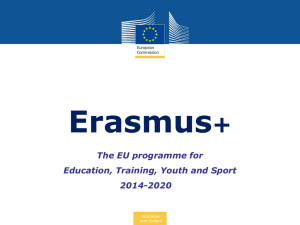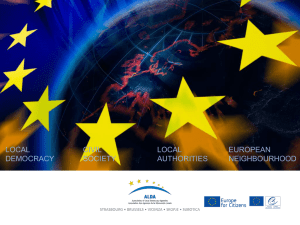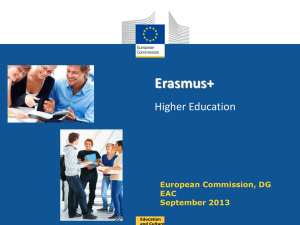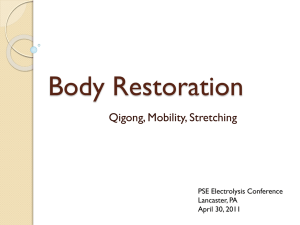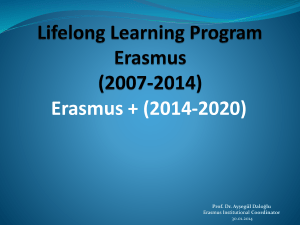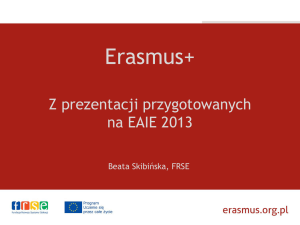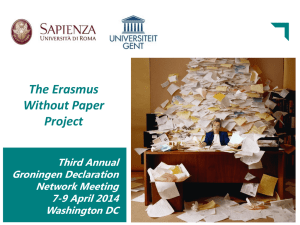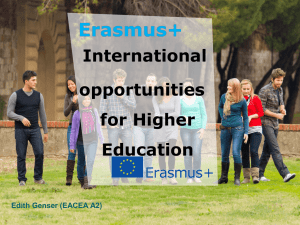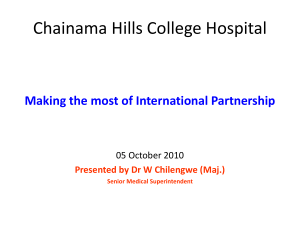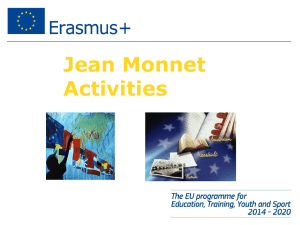appendix 3 Erasmus plus vircamp
advertisement
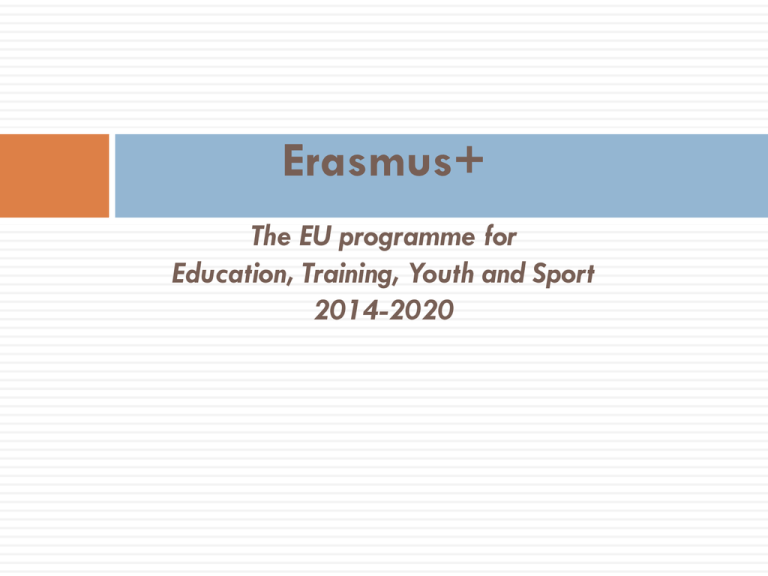
Erasmus+ The EU programme for Education, Training, Youth and Sport 2014-2020 Erasmus+: Why a new approach? • Education, training and youth: a changing landscape Deep economic crisis and high youth unemployment Vacancies exist, but skills gaps mean low employability of graduates Growing requirement for high skilled jobs Global competition for talent: internationalisation of education Extraordinary broadening of learning supply and potential of ICT Complementarity between formal, informal and non-formal learning Need for closer links with world of work => New approach necessary Erasmus+: a new approach We need: Closer links between programme and policy objectives More synergies and interaction between formal, informal and non-formal learning More cross-sectoral partnerships with world of work Stronger focus on EU added value What's new? (1) A single integrated programme Main areas: School education Higher Education Vocational education and training (VET) Adult Education Youth Bringing 7 existing programmes into a single coherent framework: KA1, KA2 o KA3, Jean Monnet Seeking to achieve greater systemic impact What's new? (2) Substantial simplifications Fewer calls and large reduction in number of actions More user-friendly programme, easier to navigate Simplified financial management. Substantial budget increase 40% increase, benefiting all sectors Additional funding from external action instruments to support International dimension of higher education Erasmus+ 3 main types of Key Action Learning mobility of individuals (KA1) Cooperation for innovation and exchange of good practices (KA2) Support for policy reform (KA3) •Mobility: staff, students, vocational education and training students • Student loan guarantee • Joint Master’s degrees • Mobility for higher education for EU and non-EU beneficiaries • Volunteering and youth exchanges • Strategic partnerships • Open method of coordination • Prospective initiatives • EU recognition tools • Dissemination & exploitation • Policy dialogue with stakeholders, third countries and international organisations • Knowledge Alliances & Sector Skills Alliances • IT-Platforms including eTwinning • Cooperation with third countries and focus on neighbouring countries Budget by Key Action 20142020 Opportunities for individuals 2 million higher education students will study and train abroad 650 000 vocational students will spend part of their education and training abroad 200 000 Master’s students will benefit from a new loan guarantee scheme and more than 25 000 scholarships for Joint Master’s Degrees 500 000 young people to volunteer abroad and take part in youth exchanges 800 000 lecturers, teachers, trainers, education staff and youth workers to teach or train abroad Opportunities for innovation projects and exchange of good practices 25 000 Strategic Partnerships, involving 125 000 institutions/organisations, to implement joint initiatives and promote exchange of experience and know-how and links with the world of work Nearly 300 Knowledge Alliances and Sector Skills Alliances, involving 3500 education institutions and enterprises working together More than 200 000 teachers collaborating online and involving more than 100 000 schools through eTwinning HIGHER EDUCATION Main topics - Higher Education - School education - VET - Adult Education - Youth Objectives KA1: Mobility - Increase skills and employability of students - Improve quality in teaching and learning -Implement the Higher Education Modernisation strategy in programme countries -Support the Bologna process and policy dialogues with strategic partner countries KA2: Cooperation for innovation and exchange of good practices KA3: Support for policy reform Key Action 1: Student mobility (1) Aims: Provide more and better opportunities to increase skills and competences of HE students, attract the best talents from abroad Main activities: Credit mobility, including traineeships abroad: mobility for studies opened to partner countries in both directions (NEW) Degree mobility: excellent Joint Master courses offered by universities from Europe and in some cases partner countries attracting the very best students worldwide Student loan guarantee (NEW): to boost Master's degree mobility within Europe Key Action 1: Staff mobility (2) Aims: Provide more and better opportunities for an increased quality in teaching and learning. Main activities: Teaching assignment: to develop innovative teaching methods, mobility opened to partner countries in both directions (NEW). Professional development: to improve skills and competences of both academic and non-academic staff, opened to partner countries in both direction (NEW). Invited staff from enterprise: to increase the relevance of curricula. Key Action 2: activities In the field of HE, the following activities are supported: Strategic Partnerships: between HEI Knowledge Alliances: HEI and Business Capacity Building Projects: Other non-European countries Key Action 2: Strategic partnerships (1) HEI strategic partnerships Aims: Strategic Partnerships offer the opportunity for organisations active in the fields of education, training and youth, as well as business, public authorities, and civil society organisations to cooperate in order to implement innovative practices leading to: high quality teaching training learning youth work institutional modernisation societal innovation Strategic Partnerships are transnational and involve a minimum of three organisations from three different Programme Countries Key Action 2: Strategic partnerships (2) Main activities: Develop, test, implement new joint curricula, joint study programmes, common modules, intensive programmes Develop project-based cooperation with enterprises to study real-life cases Exploit the potential of Open Educational Resources, collaborative and personalised learning Integrate various study modes (distance, part-time, modular) Key Action 2: Strategic partnerships (3) Project mobility actions: Long-term mobility for staff learning and training Short events for staff training Long-term mobility for secondary school students Mixed mobility for students and trainees Intensive programmes (5 days-12 months) Key Action 2: Strategic partnerships (4) Who can benefit? Any public or private organisation established in a Programme Country can take part. Organisations from other countries can participate as partners (not coordinators), as long as their participation brings clear added value to the project. Norway’s participation as a Programme Country is currently pending the finalisation of the necessary agreements HEIs established in a Programme Country must hold a valid Erasmus Charter for Higher Education (ECHE). An ECHE is not required for participating HEIs in Partner Countries, but they have to accept the principles of the ECHE Key Action 2: Strategic partnerships (5) What is the duration? Projects must last for a minimum of 2 and a maximum of 3 years How to apply? Applicants should apply by responding to the yearly call for proposals. Applications should be submitted to the National Agency of the country in which the applicant organisation is established 2014-2015 deadline: 30 April Key Action 2: Strategic partnerships (6) Award criteria Relevance of the project: 30 Quality of the project design and implementation: 20 Quality of the project team and the cooperation arrangements: 20 Impact and dissemination: 30 Key Action 2: Strategic partnerships (7) Budget Maximum: 150 000 euros (annually), 12 500 (monthly) 2-year project: 80%+20% (after final report) 3-year project: 40%+40%+20 Key Action 2: Knowledge Alliances (1) Aims To enhance structured and long-term cooperation between HEIs and business to develop innovative ways of producing and sharing knowledge in result-driven projects, particularly in emerging fields Involving a minimum of six organisations from at least three Programme Countries, of which there must be a minimum of two higher education institutions and a minimum of two enterprises Main activities Deliver new multidisciplinary curricula responding to business needs Stimulate entrepreneurship and entrepreneurial mindset of students, academic and company staff Facilitate exchange, flow and co-creation of knowledge between HEIs and business Key Action 2: Knowledge Alliances (2) What are the goals of the Knowledge Alliances? The purpose of Knowledge Alliances is to strengthen Europe’s innovation capacity by fostering innovation in higher education via balanced, two-way knowledge exchange with enterprises and across the broader socio-economic environment Who can benefit? See strategic partnerships Key Action 2: Knowledge Alliances (3) Main activities: 2 types of projects with Neighbouring and Enlargement countries, Russia, Asia, Latin America, Africa, Caribbean, Pacific (ACP) Joint projects: New curricula & degrees, learning and teaching methodologies, staff development, quality assurance, governance, Bologna tools Structural projects: Reforms at national level with support of authorities in Partner Countries (policy modernisation, Bologna policies, governance and management of higher education systems…) + Additional mobility component for ENP and Enlargement countries (without National Agency): students and staff, to and from EU, same rules as for credit mobility (max. 12 months) Key Action 2: cooperation outside EU(1) What is it? European higher education institutions and individuals can work with partner institutions outside the EU through international mobility, joint degrees, and international cooperation partnerships, including capacity building and staff development in emerging and developing parts of the world What is it for? Learning mobility and capacity building projects can improve skills, modernise higher education systems and institutions, and create better partnerships between the EU and education systems across the world. Opportunities given through Erasmus+, such as the high level Erasmus Mundus scholarships, can contribute to make Europe a more attractive study destination Key Action 2: cooperation outside EU (2) Higher education institutions can take part in collaborative capacity-building projects set up and managed by a consortium of higher education institutions from the Erasmus+ programme countries on the one hand and those from a particular region of the world on the other (the EU's neighbouring countries, Russia, EU candidate and potential candidate countries, Latin America, Asia, Africa-Caribbean-Pacific countries). These projects can be: Joint projects: these help higher education institutions from partner countries to develop, modernise and disseminate new curricula, teaching methods or materials, as well as to boost quality assurance and governance of higher education institutions Structural projects: to develop and reform higher education institutions and systems in partner countries; to enhance their quality and relevance, promote regional cooperation and increase convergence In certain partner countries neighbouring the EU, capacity-building projects will also be able to include a mobility strand targeted at students and staff from the institutions involved in the project Institutions from the regions mentioned above can submit a proposal for a capacitybuilding project under an Erasmus+ Call for Proposals Key action 3: Support for policy reform Aims: To support EU developments in HE Policy for a higher systemic impact Main activities: Support the OMC, HE modernisation agenda, Bologna process Development and implementation of EU transparency tools (ECTS, …) Recognition of qualifications (NARIC) Network of HE reform experts in Neighbouring and Enlargement countries International policy dialogue Worldwide alumni association International attractiveness and promotion JEAN MONNET Aims: To promote excellence in European integration studies in higher education These Actions also aim at fostering the dialogue between the academic world and policy-makers, in particular with the aim of enhancing governance of EU policies. European Union studies comprise the study of Europe in its entirety with particular emphasis on the European integration process in both its internal and external aspects. The discipline also covers the role of the EU in a globalised world and in promoting an active European citizenship and dialogue between people and cultures. Main activities: Teaching and research (Chairs, Modules & Centres of excellence) Policy debate with academic world and exchanges (networks and projects) Support to institutions or associations activities The creation of a Jean Monnet label Jean Monnet also provides operating grants to specified institutions JEAN MONNET activities Teaching and research Aims to support: MODULES: 40h teaching programme in the field of European Union studies CHAIRS: 90h teaching post with a specialisation in European Union studies CENTRES OF EXCELLENCE: Focal points of competence & knowledge on European Union subjects Main activities: Teaching in European integration studies embodied in an official curriculum Conduct, monitor and supervise research on EU subjects Organise and coordinate human and documentary resources related to European Union studies JEAN MONNET activities Policy debate and exchanges Aims to support: NETWORKS: Enhance cooperation and promote results on high level research PROJECTS: Explore different methodologies, promote discussion and reflection Main activities: Foster the exchange of knowledge and expertise with a view to mutually enhancing good practices Enhance cooperation and create a knowledge exchange platform with public actors and the Commission services on highly relevant EU subjects Development of academic content and tools for specific target groups Joint development of content and co-teaching JEAN MONNET activities Support to institutions or associations Aims to support: INSTITUTIONS: To enhance teacher and training activities on EU subject areas ASSOCIATIONS: Contributing to the study of the European integration process Main activities: For Institutions: Collect, elaborate, analyse and disseminate European Union facts and knowledge Organise Master’s level courses on European Union issues or professional advanced training For Associations: Organise and carry out statutory activities of associations dealing with European Union studies Publicize European Union facts among a wider public, enhancing active citizenship

